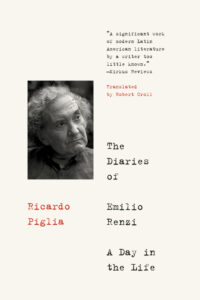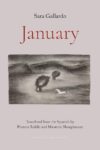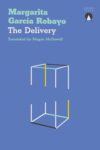
[Restless Books; 2020]
Tr. from the Spanish by Robert Croll
The atmosphere of the third volume of Ricardo Piglia’s Diaries of Emilio Renzi: A Day in the Life is on the surface defined by the military dictatorship in Argentina. Termed the plague years by Piglia, he sees the country in this period of time as a patient needing a surgical operation, to be cut open so that the ills of society may be removed. In a way that may seem familiar to readers in this time of pandemic, while life was changed forever after those seismic political events, Piglia finds much to discover in what we continue to do, rather than what ceases.
Thus the plague, and we as witnesses describe what we lived through in those dark times; my notebooks are a stunned yet serene record of life in a state of emergency. Everything seems to go on in the same way, the people work, have fun, fall in love, and there seems to be no visible signs of the horror.
These notebooks, which began in 1957 when he was 17 and number 327 in all, constitute a rigorous exploration of Piglia’s life and work, each volume evidence of his commitment to and genuine love of reading and writing. Underneath this atmosphere of the plague years is an oscillating approach to representing his life. Even as he reckons early in the book with the coup d’état (“Strange anxiety, for the first time I’m living historically”) his focus swings between the articles and books he is writing, the lectures he teaches and most importantly, the study of the double that Piglia created for himself through his alter ego, Emilio Renzi.
Iterations, or, more aptly put, repetitions of this concept, abound. These repetitions turn in on themselves; Piglia as Renzi narrates his reading of previous notebooks written by himself (as Renzi, etc.), and realizes that the relationship between what he writes and what he remembers and trusts to have occurred creates yet another sort of life. The way in which he experiences a moment, the way he then remembers the moment, and then of course how he documents it in his diaries, all vary each time.
Piglia was born in Adrogué in 1940, though soon his father moved him and his family to Mar Del Plata, after the overthrow of Perón. Events from his life dominate his novels’ themes and characters. These take the form of fragmentary strips of reality, as well as archival work, tape recordings and other found documents. As in his real life, the fragmentary nature of his work is combined with intense paranoia; conspiracy and surveillance real or imagined are pillars of his work. His diaries offer a further, and perhaps more fundamental, opportunity to see Piglia exploring his obsession with impressions, and distorted impressions, a replaying of events and conversations.
The first third of A Day in the Life is formatted as the first two volumes are: continuous diary entries, simply dated. The second section of this volume, also titled A Day in the Life, continues the autobiographical nature of Piglia’s book, but displays the writer’s attempt at a Joycean story. The story stretches over a hundred pages and narrates events over the course of a single day. While this section is the slowest of the book, and at times loses itself in attempted digressions away from the main plot, the overall effect is that of an author fully in control of his style. Though he models the structure on Joyce, the appearance of fragments and archives, of unknown information and purposefully hidden clues to the true nature of the plot, create an impressive work, which he tangentially defines as:
The life or the lives of an individual who in his distant youth wagered everything on the written word. And in that respect, it is a work of nonfiction, a true novel, a real testimony, and a historical document.
This second section tells the story of Renzi, and the death of his cousin Horacio. The idea of the double is consistent. He sees Horacio as “his double, or once had been” and imagines that they could have lived the same lives, had they made different decisions. Later on Renzi and his wife attend an art exhibition which can be viewed from the first floor, but also from a much higher vantage point: a doubled experience of visualizing art. But as Piglia has shown, different perspectives of events, and lost or missed conversation, can create a host of different paths to be taken, alternate truths to be believed. In one portion of the story, Renzi sits in a bar every day, each time wholly apart from the previous one; each day new people come and speak about new topics, nothing is ever exactly the same.
These double and triple lives and impressions that could have been are the nucleus of the idea of Emilio Renzi, and Ricardo Piglia as an artist. Underneath the all-powerful aura of Borges in Argentina, Piglia stands out for the way in which he captures the paranoid reality that has become increasingly prevalent throughout the world. This doubled concept of everything he encounters finds much of its roots in Notes from the Underground and The Double by Dostoyevsky. Piglia references these works in the first two volumes of his diaries and it is noticeable throughout in its influence. Just as Dostoyevsky reconsidered the ideas of a man living “underground” and away from society, and also the idea of the double — a doppelganger — Piglia also takes from other modes and styles and reconfigures them into his own country’s literature. And though not found in the diaries nearly so much, the use of unreliable narrators, or narrators who are missing vital information (as Yakov Petrovich is in The Double) is obvious in Piglia’s novels.
The final section of the book is a collection of scattered diary entries not yet included in the previous volumes. These entries are also far closer to the present and include thoughts on his time as a professor at Princeton University. As Piglia is dealing with ALS (he passed away in 2017 from the disease), he continues on with his work, though now dictating his diaries rather than typing. These notes on the end of his life are beautiful, and avoid the heart wrenching, or the at times strained experience of reading about impending death, and cap what is an utterly remarkable work of literature spread out over an entire lifetime.
The diaries of Piglia do not require a thorough understanding of his oeuvre, or even the history of Latin American fiction, let alone anything so difficult as the ideas of Kant or Nietzsche mentioned. Instead, the diaries require an interest and love of reading, and how we read and write, and how language exists in art separate from society. In this way, his exploration of his life becomes an exploration of all the lives he may have lived, and how one reckons with the enigma of a life constructed through language.
Teddy Burnette is a writer living in New York City. He attended the University of Oregon and received his MS in journalism from Northwestern University. He enjoys contemporary and translated literature.
This post may contain affiliate links.







